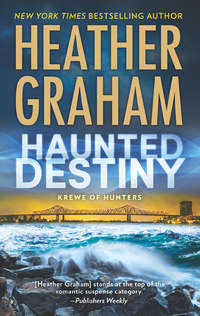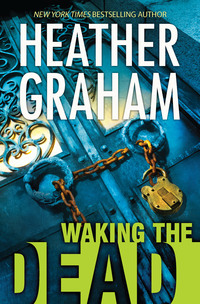
Полная версия
Ghost Shadow

Praise for the novels of Heather Graham
“An incredible storyteller.”
—Los Angeles Daily News
“Graham wields a deftly sexy and convincing pen.”
—Publishers Weekly
“If you like mixing a bit of the creepy with a dash of sinister and spine-chilling reading with your romance, be sure to read Heather Graham’s latest…Graham does a great job of blending just a bit of paranormal with real, human evil.”
—Miami Herald on Unhallowed Ground
“Eerie and atmospheric, this is not late-night reading for the squeamish or sensitive.”
—RT Book Reviews on Unhallowed Ground
“The paranormal elements are integral to the unrelentingly suspenseful plot, the characters are likable, the romance convincing, and, in the wake of Hurricane Katrina, Graham’s atmospheric depiction of a lost city is especially poignant.”
—Booklist on Ghost Walk
“Graham’s rich, balanced thriller sizzles with equal parts suspense, romance and the paranormal—all of it nail-biting.”
—Publishers Weekly on The Vision
“Mystery, sex, paranormal events. What’s not to love?”
—Kirkus on The Death Dealer
Ghost Shadow
Heather Graham

www.mirabooks.co.uk
Also by Heather Graham
NIGHT OF THE WOLVES
HOME IN TIME FOR CHRISTMAS
UNHALLOWED GROUND
DUST TO DUST
NIGHTWALKER
DEADLY GIFT
DEADLY HARVEST
DEADLY NIGHT
THE DEATH DEALER
THE LAST NOEL
THE SÉANCE
BLOOD RED
THE DEAD ROOM
KISS OF DARKNESS
THE VISION
THE ISLAND
GHOST WALK
KILLING KELLY
THE PRESENCE
DEAD ON THE DANCE FLOOR
PICTURE ME DEAD
HAUNTED
HURRICANE BAY
A SEASON OF MIRACLES
NIGHT OF THE BLACKBIRD
NEVER SLEEP WITH STRANGERS
EYES OF FIRE
SLOW BURN
NIGHT HEAT
The Bone Island Trilogy
GHOST SHADOW
GHOST NIGHT (August 2010)
GHOST MOON (September 2010)
With lots of love and thanks
to Jen Boise and “my cousin” Walt Graham,
Steve, Toni, Mike, and Lili
And for Boogie Man George and Brian Penderleith
Bernie and Petey
Titanic Brewery, Waxy O’Connor’s, Red Koi,
John Martin’s, Mr. Moe’s, Sgt. Pepper’s,
and especially, Jada Cole’s
Two Friends Patio and Ric’s
And the wonderful, crazy, historic, wild, wicked,
and sweet city of Key West, Florida
Key West History Timeline
1513–Ponce de León is thought to be the first European to discover Florida for Spain. His sailors, watching as they pass the southern islands (the Keys), decide that the mangrove roots look like tortured souls, and call them “Los Martires,” the Martyrs.
Circa 1600–Key West begins to appear on European maps and charts. The first explorers came upon the bones of deceased native tribes, and thus the island was called the Island of Bones, or Cayo Hueso.
The Golden Age of Piracy begins as New World ships carry vast treasures through dangerous waters.
1763–The Treaty of Paris gives Florida and Key West to the British and gives Cuba to the Spanish. The Spanish and Native Americans are forced to leave the Keys and move to Havana. The Spanish, however, claim that the Keys are not part of mainland Florida and are really North Havana. The English say the Keys are a part of Florida. In reality, the dispute is merely a war of words. Hardy souls of many nationalities fish, cut timber, hunt turtles—and avoid pirates—with little restraint from any government.
1783–The Treaty of Versailles ends the American Revolution and returns Florida to Spain.
1815–Spain deeds the island of Key West to a loyal Spaniard, Juan Pablo Salas of St. Augustine, Florida.
1819-1822–Florida ceded to the United States. Pablo Salas sells the island to John Simonton, for $2,000. Simonton divides the island into four parts, three going to businessmen Whitehead, Fleming and Greene. Cayo Hueso becomes more generally known as Key West.
1822–Simonton convinces the U.S. Navy to come to Key West—the deepwater harbor, which had kept pirates, wreckers and others busy while the land was scarcely developed, would be an incredible asset to the United States. Lieutenant Matthew C. Perry arrives to assess the situation. Perry reports favorably on the strategic military importance, but warns the government that the area is filled with unsavory characters—such as pirates.
1823–Captain David Porter is appointed commodore of the West Indies Anti-Pirate Squadron. He takes over ruthlessly, basically putting Key West under martial law. People do not like him. However, starting in 1823, he does begin to put a halt to piracy in the area.
The United States of America is in full control of Key West, part of the U.S. Territory of Florida, and colonizing begins in earnest by Americans, though, as always, those Americans come from many places.
Circa 1828–Wrecking becomes an important service in Key West, and much of the island becomes involved in the activity. It’s such big business that over the next twenty years, the island becomes one of the richest areas per capita in the United States. In the minds of some, a new kind of piracy has replaced the old. Although wrecking and salvage were licensed and legal, many a ship was lured to its doom by less than scrupulous businessmen.
1845–Florida becomes a state. Construction begins on a fort to protect Key West.
1846–Construction is begun on Fort Jefferson in the Dry Tortugas.
1850–The fort on the island of Key West is named after President Zachary Taylor.
New lighthouses bring about the end of the golden age of wrecking.
1861–January 10, Florida secedes from the Union. Fort Zachary Taylor is staunchly held in Union hands and helps defeat the Confederate Navy and control the movement of blockade-runners during the war. Key West remains a divided city throughout the Great Conflict. Construction is begun on the East and West Martello Towers, which will serve as supply depots. The salt ponds of Key West supply both sides.
1865–The War of Northern Aggression comes to an end with the surrender of Lee at Appomattox Courthouse. Salvage of blockade-runners comes to an end.
1865–Dr. Samuel Mudd, deemed guilty of conspiracy for setting John Booth’s broken leg after Lincoln’s assassination, is incarcerated at Fort Jefferson, the Dry Tortugas.
As salt and salvage industries come to an end, cigarmaking becomes a major business. The Keys are filled with Cuban cigar makers following Cuba’s war of independence, but the cigar makers eventually move to Ybor City. Sponging is also big business for a period, but the sponge divers head for waters near Tampa as disease riddles Key West’s beds and the remote location makes industry difficult.
1890–The building that will become known as “the little White House” is built for use as an officer’s quarters at the naval station. President Truman will spend at least 175 days here, and it will also be visited by Eisenhower, Kennedy and many other dignitaries.
1898–The USS Maine explodes in Havana Harbor, precipitating the Spanish-American War. Her loss is heavily felt in Key West, as she had been sent from Key West to Havana.
Circa 1900–Robert Eugene Otto is born. At the age of four, he receives the doll he will call Robert, and a legend is born, as well.
1912–Henry Flagler brings the Overseas Railroad to Key West, connecting the islands to the mainland for the first time.
1917–April 6, the United States enters World War I. Key West maintains a military presence.
1919–The Treaty of Versailles ends World War I.
1920s–Prohibition gives Key West a new industry—bootlegging.
1927–Pan American Airways is founded in Key West to fly visitors back and forth to Havana.
Carl Tanzler, Count von Cosel, arrives in Key West and takes a job at the Marine Hospital as a radiologist.
1928–Ernest Hemingway comes to Key West. It’s rumored that while waiting for a roadster, he writes A
Farewell to Arms.
1931–Hemingway and his wife, Pauline, are gifted with the house on Whitehead Street. Polydactyl cats descend from his pet Snowball.
Death of Elena Milagro de Hoyos.
1933–Count von Cosel removes Elena’s body from the cemetery.
1935–The Labor Day Hurricane wipes out the Overseas Railroad and kills hundreds of people. The railroad will not be rebuilt. The Great Depression comes to Key West as well, and the island, once the richest in the country, struggles with severe unemployment.
1938–An Overseas Highway is completed, U.S. 1, connecting Key West and the Keys to the mainland.
1940–Hemingway and Pauline divorce; Key West loses her great writer, except as a visitor.
1940–Tanzler is found living with Elena’s corpse. Her second viewing at the Dean-Lopez Funeral Home draws thousands of visitors.
1941–December 7, “A date that will live in infamy,” occurs, and the United States enters World War II.
Tennessee Williams first comes to Key West.
1945–World War II ends with the Armistice of August 14 (Europe) and the surrender of Japan, September 2.
Key West struggles to regain a livable economy.
1947–It is believed that Tennessee Williams wrote his first draft of A Streetcar Named Desire while staying at La Concha Hotel on Duval Street.
1962–The Cuban Missile Crisis occurs. President John F. Kennedy warns the United States that Cuba is only ninety miles away.
1979–The first Fantasy Fest is celebrated.
1980–The Mariel Boatlift brings tens of thousands of Cuban refugees to Key West.
1982–The Conch Republic is born. In an effort to control illegal immigration and drugs, the United States sets up a blockade in Florida City, at the northern end of U.S. 1. Traffic is at a stop for seventeen miles, and the mayor of Key West retaliates on April 23, seceding from the U.S. Key West Mayor Dennis Wardlow secedes, declares war, surrenders and demands foreign aid. As the U.S. has never responded, under international law, the Conch Republic still exists. Its foreign policy is stated as, “The Mitigation of World Tension through the Exercise of Humor.” Even though the U.S. never officially recognizes the action, it has the desired effect; the paralyzing blockade is lifted.
1985–Jimmy Buffett opens his first Margaritaville restaurant in Key West.
Fort Zachary Taylor becomes a Florida State Park (and a wonderful place for reenactments, picnics and beach-bumming).
Treasure hunter Mel Fisher at long last finds the Atocha.
1999–First Pirates in Paradise is celebrated.
2000 to present–Key West remains a unique paradise itself, garish, loud, charming, filled with history, water sports, family activities and down-and-dirty bars. “The Gibraltar of the East,” she offers diving, shipwrecks and the spirit of adventure that makes her a fabulous destination, for a day, or forever.
Prologue
Then
The blue light made the hallway dark and eerie, though just beyond the doors of the museum, the magic sunlight of the island glowed upon tourists and the few locals who considered early morning to be a time before noon. Traces of fog, designed for effect in the museum, lingered and created an atmosphere that was ghostly and suspenseful.
“Blood and gory guts! Murder, most foul!”
The teasing cry came from a man in the group of fifteen. He was dressed as a tourist, in shorts, T-shirt and baseball cap. His nose still bore traces of white zinc and, as typical of most tourists, he was sporting a sunburn that would soon hurt.
“No, death most absurd,” David Beckett corrected. He had to admit—he loved filling in as a tour guide, and had been glad to give Danny Zigler, the weekend tour host, time off.
“Ooh,” murmured one of the teenaged girls.
David heard a small, aborted laugh. It came from Pete Dryer, Key West policeman, who happened to be on the tour with his sister, brother-in-law, niece and nephew, family down from Fort Lauderdale for a few weeks during summer break.
“This is going to be dramatic, folks,” Pete teased.
“Our next exhibit is definitely one of our most bizarre stories—even in a place where the bizarre is quite customary,” David said.
They had been moving at a steady but relaxed pace through the exhibits. The museum was a family business, and covered all of the colorful history of Florida’s Key West. Each major event was shown in an incredibly detailed and authentic tableau. The tableaux were not wax. Once upon a time, the place had been a small wax museum, but David’s grandfather, something of a mechanical and electrical genius, had avoided the constant loss of wax figurines when the heat soared in Key West, when storms came through, when air-conditioning ceased to work. The figures in the exhibit were brilliant mechanical masterpieces.
The group was heading to David’s favorite historical exhibit. He grinned and said as an introduction, “A story of true love to some—true evil and wickedness to others.”
A few of the young women in the crowd of tourists smiled, as well. David played the part of host well, he thought, and had the right appearance for it. He was tall, dark-haired and in damned decent shape at the moment, thanks to the navy. He wore a top hat and Victorian cape, though why that was the uniform, he wasn’t sure. Many of the women and girls in the crowd were nervous—museums with tableaux often made people nervous, and many of the figures here were so realistic that it did seem they might come to life. David was enjoying himself. It was good to be home, and good to be dealing with the family business for a stint, giving employees time off here and there, even if he wouldn’t be staying for long right now. Finished with the military, he was headed to the University of Florida—a bit old for a freshman, but he’d be going on the “uncle” he’d so recently served, Uncle Sam.
The blonde in the Hog’s Breath Saloon T-shirt and short-shorts was really cute, he thought.
He felt a moment’s guilt; he wasn’t accustomed to feeling free to flirt when he met a lovely young woman. He’d been engaged. He’d had a fiancée he loved, that is until he’d returned home to find out that Tanya had decided that she was moving north with a football player who’d come down to Key West from Ohio State.
It hurt. It still hurt. But his time in the military had driven them apart. They had dated all through high school. It had seemed like real love. But it hadn’t been. Not on Tanya’s part, at least.
But he had been gone often, and for long periods, and maybe it was just natural that she had moved on. Now, he needed to do the same.
He stopped just before his favorite tableau and said, “Carl Tanzler was born in Dresden, Germany, and came to the United States via a circuitous route that took him to Cuba, Zephyrhills, Florida, and finally down to Key West. Here he worked as an X-ray technician at the U.S. Marine Hospital, while, for some reason, his wife remained in Zephyrhills with his family. Now, when he was young, so the story goes, he had visions, and his grandmother encouraged those visions. One was a beautiful dark-haired woman who would prove to be his true love.”
“Typical—his true love wasn’t his wife,” the blonde woman said. David thought one of the college girls with her group had called her Genevieve. She looked like a Genevieve. Really pretty face, beautiful eyes.
“It wasn’t his wife?” Pete’s sister, Sally, said. “His true love wasn’t his wife?”
Her husband, Gerry, laughed and gave her a hug.
“Nope, not his wife,” David agreed. “One day, into the hospital walked a stunning young Cuban woman named Elena de Hoyos. Sadly, the young woman suffered from tuberculosis. Carl—who called himself Count von Cosel—fell instantly in love with her. Problems abounded. He had his wife, and Elena was married, as well. Ah, but that particular problem was quickly solved, because her husband left her as soon as the diagnosis was made. Carl swore to her and her family that he could cure her. At the time, though, there was nothing at all that he could do, even though he ingratiated himself to the family and was a constant guest in their home with his cures. When Elena died on October twenty-fifth in nineteen thirty-one, he offered to build her a beautiful mausoleum, which he did, and he visited it night after night, playing music for her, speaking to her in her grave, giving her gifts.”
“That’s sad and tragic,” an older woman offered. She had zinc on her nose, too. She seemed to be the wife of the fellow with the sunburn. Her shade almost matched his.
“Yes, well, one day, he quit visiting. Now, folks, this is Key West, Florida. For the next several years, Carl Tanzler, Count von Cosel, spent his days buying perfume, mortician’s wax, wire and women’s lingerie and clothing, and no one really seemed to notice. Then one day, Nana, Elena’s sister, heard rumors that Tanzler was sleeping with her sister’s corpse. She accosted Tanzler, and he was soon arrested. Now, legend has it that Nana let him have three days with the body before the police came in to take him, but I’m not sure I believe that bend in the story. Tanzler was taken into custody. He was examined by psychiatrists. Just to prove the rest of the country can be as crazy as folks in Key West, the story became romanticized in papers across America. Eventually, Tanzler was released—the statute of limitations for disturbing a grave had run out. An autopsy suggested that the man had been practicing necrophilia for years. Tanzler’s own memoirs speak of his love for Elena and his belief that they would fly to the stars together as man and wife, since he had married her in a secret and private ceremony. Elena was given a second viewing at the Dean-Lopez Funeral Home. Maybe five or six hundred people attended her first, thousands attended her second. Our next display is one that recalls the famous story of true love—Carl Tanzler stands by the bedside of his bride.”
With those words, David strode into the next room, his arm sweeping out dramatically.
He frowned, startled by the sudden silence.
Then the blonde screamed. It was a tragic and horrible scream, and he was destined to hear that sound over and over again in the years to come.
David turned.
The robotic recreation of Carl Tanzler stood just as usual, a small, thin-faced man with a balding head at the rear of the bed, bending over Elena Milagro de Hoyos.
But the body on the bed was not Elena’s.
He didn’t scream. He felt as if ice washed over him and permeated him, blood and bone.
A woman lay on the bed.
But it was not the model of Elena!
She wasn’t dark; she was blonde. Her hair, long and lustrous, fell over the pillow and curled down the side of the bed. Her eyes, blue and open, stared at the ceiling in frozen horror. She was wearing a sundress, and while stretched out in a natural pose, she might have been getting her beauty sleep had it not been for her eyes, staring sightlessly in terror.
David felt his knees buckle. Only the ice in his veins kept him standing.
Blood and guts! Murder most foul!
There was no blood. But it was murder. Despite the pristine beauty of her body as she lay, dark gray bruises were apparent around her neck.
It was murder. The murder of a beautiful young woman.
Not a stranger. Not just any woman.
It was Tanya, his ex-fiancée.
Chapter One
Now
“Personally, I think you’ve taken on way too much,” Clarinda said, voicing her opinion in a loud whisper next to Katie’s ear. She had to come down to Katie’s ear to be heard so close to the sound system. A drunken frat boy from Omaha was in the midst of a soulful Alice Cooper song, the bar was full and the noise level was high.
Katie shrugged and grinned, looking up at her friend. Maybe she was taking on too much, but an opportunity had come up, and she hadn’t been able to resist.
“It will be wonderful, it will work out—and it will be good for Key West,” Katie said in return.
Clarinda arched a doubtful brow, set down a glass of water with lime on the small table at Katie’s side and shook her head. “I’ll help you, of course,” she said. “And, you know, Danny Zigler will be delighted to come and work for you. He was heartbroken when the place shut down years ago. People say that it’s haunted, of course. You know that, right?”
“So I’ve heard,” Katie said.
“Sweetie, can we get another round over here?” a man shouted above the din.
“Just don’t call me sweetie,” Clarinda said, exhaling a sigh of exasperation. “What is this tonight? We usually get the locals who actually know how to hold their liquor.”
“Gee. We’re in Key West and we’ve been discovered by tourists. Go figure,” Katie said.
“Yeah, well, I wish I were the karaoke hostess and not the waitress,” Clarinda said.
“Hey, I’ve told you that you can work for me—”
“And when the place is slow and the hostess is supposed to sing, I assure you that I’ll clean out not just the bar, but the entire street. No—eventually, I’ll make my fortune doing caricatures on Mallory Square, but until that day, I’ll be your support by helping drunks get drunker and therefore hand out big tips. Okay, that helps both of us.”
“Sweetie!” the man called again. “Another round!”
“He’s going to get the round on top of his head,” Clarinda promised and strode toward the bar.
The Alice Cooper tune was winding down. Next up was a fellow who wanted to do Sinatra. Katie applauded both the man returning to his seat and the one walking up to the microphone.
Stumbling up to the microphone. What was it with tonight? It was true—the strange and totally inebriated seemed to be coming out of the woodwork. Well, it was Key West. Home to some, but mainly a tourist town where the primary activity was drinking too much.
Key West has much more to offer, she thought, defending her native territory. The fishing was excellent, diving was spectacular and many visitors came for the water sports. But it was true as well that young and old flocked from far and wide to Jimmy Buffett’s Margaritaville for the sheer pleasure of a bachelor party, or just wild nights along Duval. Duval was the hub of nightlife, and it was the main place for cheap hotel rooms.
Her place—or her uncle Jamie’s place, O’Hara’s, where she ran Katie-oke—was off the southern end of Duval while most of the more popular watering holes were at the northern end. She did tend to draw a lot of the locals. Many of the entertainers who worked at the festivals—Fantasy Fest, Pirates in Paradise, art fests, music fests, Hemingway Days and more—came in to practice their newest songs with Katie. She operated Katie-oke four nights a week. She also worked at O’Hara’s when she wasn’t doing karaoke, helping set the sound and stage for performers working on their own music, or doing easy acoustic and vocal numbers on Monday and Tuesday nights.











